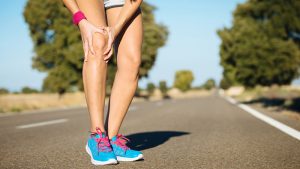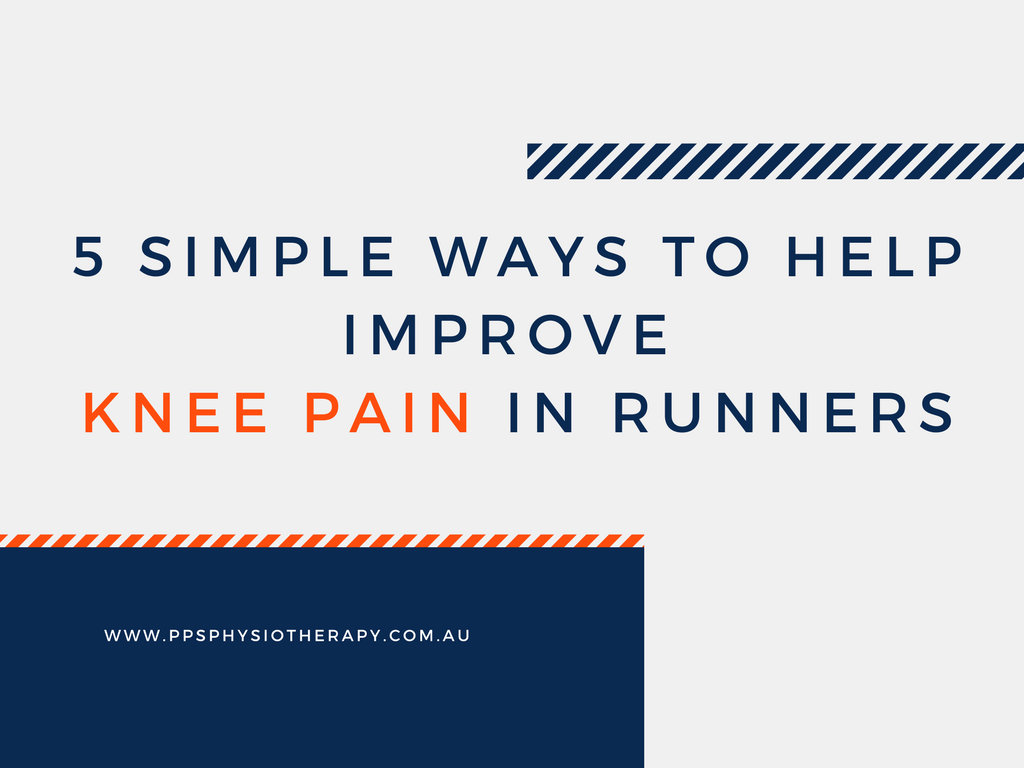January 21, 2017 by Grant Burton Master of Physiotherapy; B.Ex.Sci
Between 19.4 to 79.3 percent of runners suffer from knee pain, making it one of the most common lower extremity injuries (1). When we suffer from knee pain one of the most common options for treatment is physiotherapy. Physiotherapists are trained to assess, examine, diagnose and treat knee pain to help patients return to running – efficiently and safely.
The majority of knee pain associated with running is usually due to improper loading (poor running technique) causing repetitive micro trauma/irritation to the knee joint and surrounding structures. To be able to run effectively a runner needs to be able to absorb the weight of his/her body when their foot hits the ground in order to propel them forward. Running is complicated (although it might not seem like it) and unfortunately most people do not actively practice their running technique, or even have a clue what it takes to be an efficient runner.

Knee pain can start at any time during a run, but most commonly is experienced after running longer distances. Research shows that the more kilometres you run the higher the risk of sustaining a knee injury (1). Some of the most common causes of knee pain in runners are patellofemoral pain (runner’s knee), iliotibial (IT) band syndrome, knee Osteoarthritis, and patellar tendon pain.
It is common for runners to treat their own knee pain, independently of physiotherapy. Most patient’s we see trial the old rest and ice and hope their pain just magically goes away on its own (with little success). Although rest can help during the initial stages of knee pain, there are numerous ways that runners can take load off their knees and prevent future injuries, including (but not limited to) the five listed below:
- Improve Hip Flexor and Quadriceps Mobility
Stretching & foam rolling are some of the most efficient ways to improve hip flexor and quadriceps mobility to lessen knee pain. One of our favourite stretches for Hip flexor mobility is called “The True Hip Flexor Stretch”. For more information on stretching and foam rolling contact us.
- Improve your Gluteal (bum) muscle strength
As we are society of sitters, sitting all day causes our glutes to become lazy and in turn become weak. The gluteal muscles are the largest muscles in the body and when trained properly, can lessen the load taken on the knee joint. The easiest way to improve strength of the gluteal muscles is with bodyweight exercises including seated band hip abductions, monster walks, sumo walks, hip thrusters, bridges, planks, and side planks.
- Improve your Balance
As mentioned earlier running requires the ability to land on one leg repeatedly to propel the body forward. The knee is the middle connection between the ground and the body. The knee is subject to the hip and the ankle. A loss in balance can lead to poor force absorption from the ground with each step taken during running.
To test your balance, try standing on one leg, with your eyes open and without using your arms for support. Bend your non stance leg to 90 degrees of hip flexion and see if you can hold this for 30 seconds. If you can’t guess what – your balance is poor and you need work, but the good news is balance can be improved by practice!!! To take this balance test/exercise a step further, try balancing on one leg without holding onto anything with your eyes closed. If balance continues to be a problem, consider scheduling an appointment with one of our friendly physiotherapists at PPS PHYSIOTHERAPY KELLYVILLE OR CARLINGFORD – we have a heap of balance exercises waiting for you!!
- Improve Core Position/Stability and muscular imbalances
Core training improves your ability to control muscles and movements. It develops strength in muscles that lie deep in the abdomen and connect to the spine, pelvis and shoulders. This then helps you to maintain good posture, balance and co-ordination, run with a better technique or more efficient running style and so reduce the risk of injury through extreme range of movement or excessive forces going through your body.
Unfortunately most of us have very poor posture and core stability. This can be due to modern lifestyles that see us sitting for most of the time. Many people sit at computers all day and in front of televisions in the evening and so we have stopped using key muscles that should be used to maintain a strong, upright posture. Many runners don’t ‘fire’ and use their ‘glutes’ or muscles in the backside or the deep abdominal muscles. The good news is that you can retrain these muscles and enjoy improved running form.
Some of our favourite core exercises include – the deadbug, the pallof press, planking the RKC plank and side-planking. If you would like to learn more about these exercises and how to perform them correctly contact one of our friendly physiotherapists.
- Improve your ankle mobility The knees’ job is to stabilize your leg when you run, and they have very limited range of motion in rotating. When you change direction when running, your ankles must either invert/evert/dorsiflex/plantar flex, supinate or pronate, or roll toward the outer or inner part of your feet, respectively. If your ankles are stiff, then this completely changes the mechanics of your knee and in turn the amount of force/load being put through the knee joint. To put simply ankle stiffness can cause a chain reaction of stiffness and pain up to your knee joints, hip joints, lower back, and even shoulder girdle.
To improve your ankle mobility one of our favourite exercises is called the Knee to wall stretch – Kneel down on the ground onto one knee, with one leg out in front of your body (as if you were going to propose to your partner), with the leg that’s out in front of the body, keeping the heel flat on the ground, move your knee over your ankle joint (aiming for the direction of the little toe) as far as you can, you may feel a stretch in your calf or Achilles repeat this mobilisation movement for 3 sets of 20 with a 1-2 second hold at the end of the movement (Note: if you feel a pinch in front of your ankle – this is a whole other ball game and you need to see your physiotherapist).
If you need help with returning to running or your knee pain, make a booking with one of our friendly physiotherapists. See you on the track!!!!

